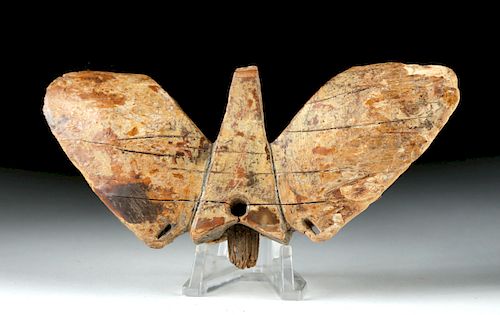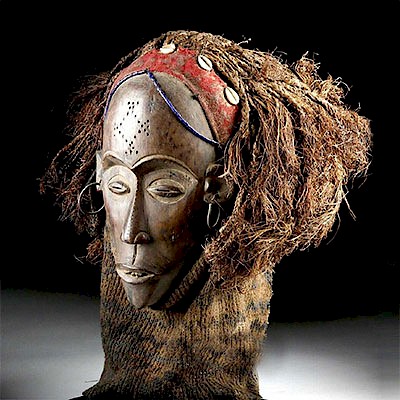Prehistoric Inuit Fossilized Bone Atlatl Stabilizer
Lot 97e
About Seller
Artemis Fine Arts
686 S Taylor Ave, Ste 106
Louisville, CO 80027
United States
Selling antiquities, ancient and ethnographic art online since 1993, Artemis Gallery specializes in Classical Antiquities (Egyptian, Greek, Roman, Near Eastern), Asian, Pre-Columbian, African / Tribal / Oceanographic art. Our extensive inventory includes pottery, stone, metal, wood, glass and textil...Read more
Estimate:
$3,000 - $4,500
Absentee vs Live bid
Two ways to bid:
- Leave a max absentee bid and the platform will bid on your behalf up to your maximum bid during the live auction.
- Bid live during the auction and your bids will be submitted real-time to the auctioneer.
Bid Increments
| Price | Bid Increment |
|---|---|
| $0 | $25 |
| $300 | $50 |
| $1,000 | $100 |
| $2,000 | $250 |
| $5,000 | $500 |
| $10,000 | $1,000 |
| $20,000 | $2,500 |
| $50,000 | $5,000 |
| $100,000 | $10,000 |
| $200,000 | $20,000 |
About Auction
By Artemis Fine Arts
Apr 4, 2019
Set Reminder
2019-04-04 10:00:00
2019-04-04 10:00:00
America/New_York
Bidsquare
Bidsquare : Ancient / Ethnographic From Around The World
https://www.bidsquare.com/auctions/artemis-gallery/ancient-ethnographic-from-around-the-world-4003
Ancient art from Egypt, Greece, Italy and the Near East, as well as Asian, Pre-Columbian, Native American, African / Tribal / Oceanic, Spanish Colonial, Russian Icons, Fine art, much more! All categories, all price ranges... all legally acquired and guaranteed to be as described or your money back Artemis Fine Arts info@artemisfinearts.com
Ancient art from Egypt, Greece, Italy and the Near East, as well as Asian, Pre-Columbian, Native American, African / Tribal / Oceanic, Spanish Colonial, Russian Icons, Fine art, much more! All categories, all price ranges... all legally acquired and guaranteed to be as described or your money back Artemis Fine Arts info@artemisfinearts.com
- Lot Description
Native American, Alaska, Inuit, Aleutian, or Punuk peoples, Prehistoric period, ca. 100 to 1000 CE. A finely-preserved stabilizer finial carved from marine mammal bone, likely walrus, that exhibits a smooth texture formed through the process of fossilization. The stabilizer has a pair of broad wing-form projections with pierced lower attachment slots, a central conical tab, and a large attachment slot flanked by a pair of smaller drilled attachment holes. The atlatl is a lengthy pole used to increase the distance, velocity, and accuracy of a thrown spear. The lateral wings of the stabilizer emulate the feathers on an arrow by stabilizing the structure of the atlatl pole and by mitigating aerodynamic drag when thrown. A small dowel is still slotted within the central opening. A rare example of early Inuit hunting tools! Lucite display stand for photography purposes only. Size: 5.1" W x 2.375" H (13 cm x 6 cm).
For a drawing of a stylistically-similar example, please see: Mason, Owen K. "'The Multiplication of Forms:' Bering Strait Harpoon Heads as a Demic and Macroevolutionary Proxy." From "Macroevolution in Human Prehistory: Evolutionary Theory and Processual Archaeology." Springer Publishing, New York, August, 2009, Chapter 3, p. 88, fig. 3.5, middle example.
Provenance: private southwestern Pennsylvania, USA collection
All items legal to buy/sell under U.S. Statute covering cultural patrimony Code 2600, CHAPTER 14, and are guaranteed to be as described or your money back.
A Certificate of Authenticity will accompany all winning bids.
We ship worldwide and handle all shipping in-house for your convenience.
#144752Small nicks to lateral wings, central tab, and attachment hole, with several stable fissures, and light encrustations. Nice earthen deposits and smooth patina throughout.Condition
- Shipping Info
-
All shipping is handled in-house for your convenience. Your invoice from Artemis Gallery will include shipping calculation instructions. If in doubt, please inquire BEFORE bidding for estimated shipping costs for individual items.
-
- Buyer's Premium



 EUR
EUR CAD
CAD AUD
AUD GBP
GBP MXN
MXN HKD
HKD CNY
CNY MYR
MYR SEK
SEK SGD
SGD CHF
CHF THB
THB















